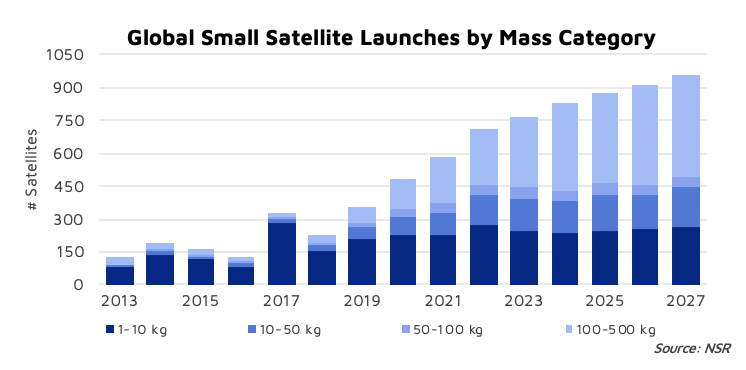|
The Unintended Consequences of Smallsats
April 3, 2019 by Shagun Sachdeva | NSR
“Cumulative
smallsat market value to reach $37 billion by 2027”
according to NSR’s Small Satellite Markets 5th
Edition report. As significant as this
statistic is, the more consequential one is that
there will be 6,500 small satellites in orbit by 2027.
While the overall growth of the smallsat market is
beneficial for the space economy as it is helping lower
the barriers to entry and create new revenue streams in
the (relatively) near term,
the impact of this growth on the space ecosystem in the
long term is less often discussed.
In 2009, Iridium satellite collided with a
non-functional and therefore un-controlled Kosmos 2251
satellite – which by ESA’s definition is considered
space debris. No prior warning of a possible collision
was considered as the reason for this collision. While
it is hard to accurately forecast a collision
probability,
the relevant factors to consider are the number
satellites in orbit, maneuverability of those
satellites, debris in orbit at the time and the ability
to track the objects in order to provide prior warning.
With the increasing number of satellites and the
increasing debris (from either collisions or events such
as the recent ASAT launch by India), it can be agreed
that more collisions in the near future are more than
certain.
While this issue is relevant to all satellites in all
orbits,
it is more of a concern for smallsats for two main
reasons: Firstly, smallsats comprise the
largest share of total satellite launches over the next
decade due to the high number of constellations planned
as well as the higher number of satellites per
constellation in cases like OneWeb and SpaceX’s
Starlink. Secondly,
due to the small size of some of these smallsats, it
makes it quite challenging to track them to be
able to provide accurate and timely warnings. These
issues lead to a higher risk of collision – either with
each other or with existing debris in orbit, which
further lead to more debris, also known as Kessler
Syndrome.

NSR’s Small Satellite Markets report estimates that 39%
of all smallsats launched over the next 10 years will be
<10 kg. The report also discusses the growing
trends of pico sat (< 1 kg) launches. Most of the
existing space situational awareness (SSA) capabilities
are not able to accurately and precisely track objects
less than 10cm, which makes small satellites and
especially any small debris created from these
satellites almost impossible to track. The relatively
low maneuvering capability of some of these smallsats
muddy the waters further.
Over the years the issue of space debris has become more
recognized. This has further led to a growth in SSA
providers – with a wide range of services, and various
end-of-life disposal capabilities. Unfortunately, while
these service providers are helping the technology get
up to speed fast,
the market is not ready to utilize these services – most
of which not acknowledging the severity or the urgency
of the issue.
Bottom Line
Smallsats have brought about a very welcome and much
needed change to the space industry. It has bridged the
gap between innovation and implementation. The ability
to have an impact on the grass root level using
satellites has also become possible because of the use
of smallsats. However, while the impact here on Earth is
known and emerging,
it might be time to consider the impact that this
growing market is having in space, especially with our
fast-growing reliance on space-based applications.
Subscribe to talksatellite weekly newsletter -
circ@talksatellite.com
|